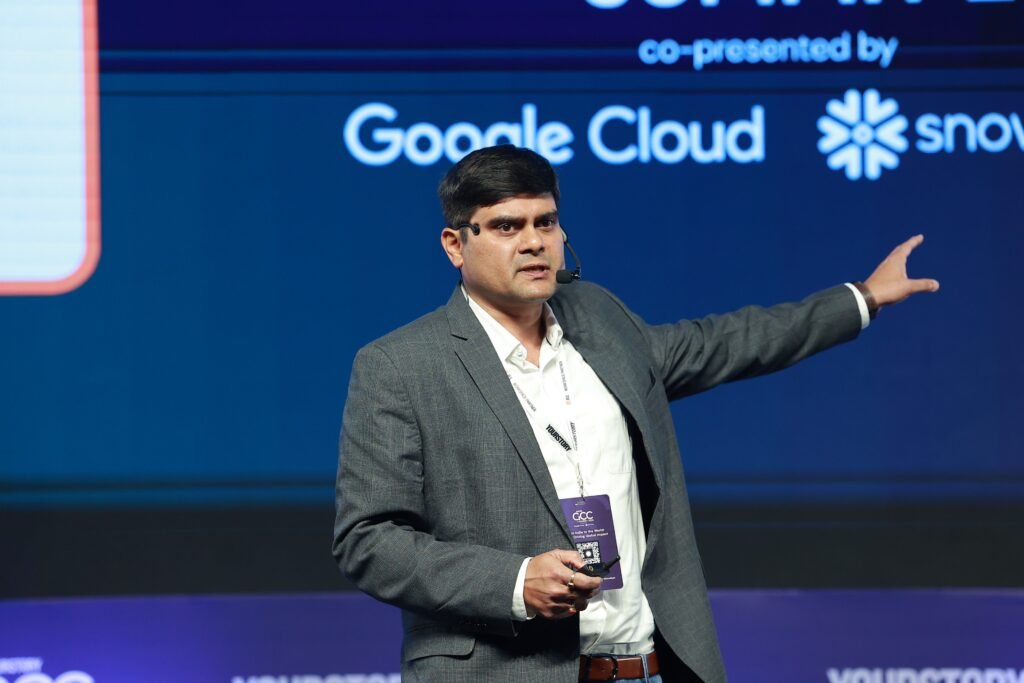
As enterprises accelerate their digital transformation journeys, Global Capability Centers (GCCs) are playing a pivotal role in leading innovation, scaling AI adoption, and delivering business impact. In this evolving landscape, Google Cloud is positioning itself as a strategic enabler–offering a unified, vertically integrated platform that seamlessly connects data, infrastructure, and AI.
At the YourStory GCC Summit 2025, Arun Ramamurthy, Enterprise Sales Leader, GCC, Google Cloud, led the session ‘Winning with Google Cloud’s Agentic Data-to-AI Platform: A Blueprint for GCC Success’. He introduced a bold shift from generative to agentic AI, positioning it as a catalyst for greater autonomy, faster decision-making, and enhanced productivity across GCCs.
<div class="externalHtml embed" contenteditable="false" data-val="”>
The session opened with a demonstration of Project Astra, an experimental AI assistant from DeepMind, Google’s AI research division. Through dynamic interactions that involved multimodal recognition, contextual memory, live object detection and even coding support, the video illustrated a significant leap in agentic AI capabilities.
“We call it the art of the possible in Google. We are inculcating similar capabilities in our own AI products, which we are offering to GCC enterprises. We have been innovating and researching for the past decade,” Ramamurthy explained.
A deep foundation in AI innovation
Ramamurthy highlighted Google’s decade-long AI leadership, tracing it back to TensorFlow’s launch in 2015 and the 2017 introduction of the Transformer architecture–now the backbone of most large language models.
“We have been innovating in the AI space year on year and are trying to make not only human lives better but offer those capabilities to GCC enterprises to reimagine their own business enterprises,” he shared.
At the heart of this transformation are new capabilities that were unveiled at Google Cloud Next, including AlphaFold 3–DeepMind’s advanced AI model for predicting 3D protein structures. With breakthrough accuracy, it promises to accelerate drug discovery and unlock deeper insights into human biology.
On the infrastructure front, Ramamurthy highlighted Ironwood—Google’s seventh-generation TPU, delivering over 42 exaflops of performance. Surpassing the world’s most powerful supercomputers, it gives GCCs unmatched scalability for AI workloads.
He also spotlighted Willow, Google’s new quantum chip that significantly reduces error rates and is a major leap in quantum computing. Together, these innovations reinforce Google Cloud’s push toward a future-ready compute stack for advanced enterprise demands.
Expanding creative intelligence with Gen AI
Google Cloud’s generative AI advancements are equally striking. Veo enables 4K video from text, Imagen 3 powers high-fidelity image generation, and Lyria, built for music, has been tested with Shankar Mahadevan, exploring new frontiers in AI-assisted creativity.
Gemini 2.5, Google’s most advanced large language model yet, offers reasoning, multimodal capabilities, and enterprise-grade performance, powering next-gen AI applications across industries.
“It can do a long contextual window of 1 million tokens. We are still developing it to reach the 2 million mark soon. Some of the global enterprises, for which GCCs are present in India, are already doing some key innovations with these technologies,” Ramamurthy said.
Here are some examples: L’Oréal is using tools like Veo, Imagine, and Gemini to fuel its AI labs and create sharper marketing differentiation. Volkswagen is embedding these capabilities into its supply chains and vehicles, while Vodafone is deploying AI in its networks to cut costs and boost efficiency.
The transition from generative to agentic AI
One of the most important distinctions introduced in the session was the difference between generative and agentic AI. While generative models produce outputs based on user prompts, agentic AI is designed to reason, plan and act autonomously.
Ramamurthy likened the difference to that between a personal assistant and a strategic manager. “Agentic AI does not wait for instructions; it proactively executes tasks, collaborates across systems, and makes informed decisions, all while remaining under enterprise control,” he added.
To enable this shift, Google Cloud launched Agent Space, a platform for building intelligent agents. It can act like internal search engines and help retrieve data, trigger workflows and navigate complex systems for teams.
The true power of agentic AI emerges when paired with data. Google Cloud’s Agentic Data-to-AI Platform brings intelligence into the enterprise data stack. As Ramamurthy noted, most GCCs are data-rich but insight-poor, with analysts still bogged down by repetitive tasks like transformation, querying, and reporting.
Google’s new approach embeds intelligent data agents into the stack to automate tasks and optimise performance. Whether it is data engineering, real-time analytics or model deployment, these agents streamline the entire lifecycle.
“What makes the platform unique is its foundation in three principles: an agentic-first design, a unified architecture that allows for seamless integration across environments, and flexibility that honours enterprise choice–allowing users to work with multiple models, cloud providers, and tools,” Ramamurthy shared.
Building the enterprise nervous system
Describing Google Cloud’s vision as building the intelligent nervous system of the enterprise, Ramamurthy explained that it isn’t about adopting AI in isolated pockets. Instead, the need of the hour is
to create an architecture where intelligence is embedded at every level of the organisation.
For GCCs, this represents a significant opportunity. With Google Cloud’s Agentic Data-to-AI Platform, they are not only able to drive operational efficiency but also reimagine their role as global centers of innovation, insight, and strategic execution.
AI at scale is no longer theoretical–it is actionable and enterprise-ready.

